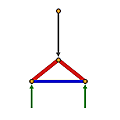

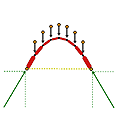
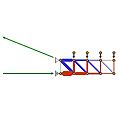
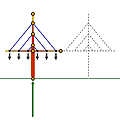
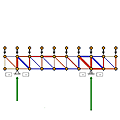
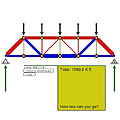

Active Statics
Active Statics is a set of eight highly interactive demonstrations that involve the user in experimentation with the relationship between structural form and forces. For maximum transparency and creative potential, these demonstrations are based on graphic statics, a body of techniques used by such masters as Antonio Gaudi, Gustave Eiffel, and Robert Maillart to create their structural masterpieces. The external forces on each structure are plotted to a scale of length to force on a load line. Working from the load line, the forces in the members of the structure are determined by scaling the lengths of lines constructed parallel to the members. The diagram of forces that results from this process is called the force polygon. In these demonstrations, the force polygon is constructed automatically and revised instantly and continually as changes are made in the form or loading of the structure. The intensities of member forces are indicated by the lengths of the line segments in the force polygon, the numerical values in a table, and by the thicknesses of the members themselves. All components of each demonstration are color-coded: Blue indicates tension, red is compression, yellow is zero force. External loads are black and reactions are green.
Before you begin, you should have some familiarity with the rudiments of graphic statics. These can be learned from Zalewski and Allen, Shaping Structures: Statics (New York, John Wiley & Sons, 1998, ISBN 0-471-16968-4), and from the companion CD-ROM lessons in graphic statics by Joseph Iano (New York, John Wiley & Sons, 1998, ISBN 0-471-28338-X).
Active Statics is available free online for the time being. In return for its use, we would like your feedback so that we can continue to expand and improve the system. Active Statics should run under any version of Windows, MacOS, or Linux in any Java-enabled web browser. Please let us know if it doesn't. We are in the late stages of bringing it to a final release.
Use
Active Statics online.
These will work best if you have broadband Internet access. Otherwise
they will take a long time to load. For people with slower connections,
we recommend that you download the demos and run them locally.
Download
v002.
To run simply, unzip ActiveStatics.zip and open Start.html.
This version will run locally, which is useful for machines without broadband
Internet access. (Zip files can be unzipped on Windows PCs using any of
a number of free utilities. One good one is called WinZip, and it is available
from www.winzip.com.)
License
The contents of this site are © 2003, Simon Greenwold and Edward Allen. You are free to use this for yourself or with a class. Please direct people to this site for distribution rather than distributing it yourself. You may not include these demos or images of them in your own materials without permission of the authors.
Feedback
We would like to hear from you. We maintain a mailing list for people who would like to keep informed of news and updates to Active Statics. This also helps us get a feel for how many people are using the system. (It is used for no other purpose, and we will remove you at your request.)
Bug reports, questions, comments, praise, etc.
People
Simon
Greenwold, author of Active Statics demos.
(simong@media.mit.edu)
Edward Allen, author of Active Statics manual,
co-author of Shaping
Structures: Statics. (allenarch@compuserve.com)
Waclaw Zalewski, co-author of Shaping
Structures: Statics. (zal1@ix.netcom.com)